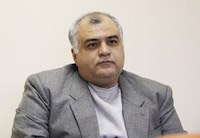Rationalization of Oral History Books (part III)
Rationalization Is Variable Over Time
Akram Dashtban
Translated by: Fazel Shirzad
2018-6-12
Note: Following report is based on an invitation in which history experts are asked questions about oral history. In this regard, one of experts, as his perspective, has answered to one of questions titled "The amount of rationalization and appendix in oral history books". We'll read these comments as follows.

In an interview with Iranian oral history website, Seyed Qasem Yahusseini, writer and researcher of history, spoke about rationalization: "The rationalization is explanation and description of ambiguous contents of a text that appears in the footnote or appendix. Rationalization about photo also includes a description of historical photographs and information on place, time and photographer.
He believed that rationalization is relative, and added: "Rationalization are different among people. If a book, for example, is written for students, there is a different way of rationalization in writing the book by researchers. In fact, rationalization is different over historical times. If an author wrote a book about Gholam Hossein Sa'edi or Dr. Ali Shariati in 1360, s/he wouldn't need for a rationalization, but today if a book is written about Shariati, many topics should be rationalized in footnote or the end of book. In other words, rationalization is a floating issue that is different according time and place. For example, if you write a book about province Bushehr, you do not need rationalization to explain places, but if it is a country issue, places and other parameters should be rationalized.
Yahusseini went on to say that oral memory is a subset of oral history, and rationalization is not same in these two formats, and added: "The book's rationalization should not be long. All the terms should not be mentioned in it, except in rare cases; in the manner in which author himself/herself has gained that information. For example, Raheem Raisnia published a book titled "The Last Bulwark of Liberty". This book included the series of articles by Seyed Ja'far Pishevari published in Haghighat[1] newspaper and its publisher named Seyed Mohammad Dehghan. Raisinia, at the end of book of Seyed Ja'far Pishevari, introduced newspaper Haghighat and Seyed Mohammad Dehghan and presented piece of information that was published for first time; or appendix of Mohsen Kazemi's books [1]which is as an independent investigation.
He explained in more detail about the amount of rationalization in books: The text should be so perfect that it does not need to be rationalized, the text included in the footnote should be brief and minimal. If something is written by referring to generations, places or people, it should be mentioned in general terms, and if rationalization is about geographic location, it should be mentioned alphabetically.
Yahusseini further referred to rationalization of photographs in oral history books and said: "If a photo is rationalized accurately, it will become a document in which you must mention location, persons in the photo, the date of the photograph and, as far as possible, the name of the photographer."
He goes on to say that rationalization is considered as a advantage of a work:" In the past, it was a very difficult task to rationalize, but today it's easy to do by using internet and various research sites. Rationalization allows addresses to get acquainted with characters, and gaining references and additional resources as well. The more book is power in providing references and resources, the more book is valuable text for readers. Of course, author must be careful that rationalization of book not to be an inappropriate one.
Iranian oral history website asks question to experts about oral history, and publish responses to readers. Total responses will have remarkable results. If you have any questions, please feel free to submit it via this page to read comments from experts of oral history!
Number of Visits: 4460








The latest
- The Necessity of Standardizing Oral History and Criticism of General Mohsen Rezaei
- The 368th Night of Remembrance – Part 1
- Oral History News of Khordad 1404 (May 22nd – June 21st 2025)
- Najaf Headquarters Human Resources
- The Embankment Wounded Shoulders – 12
- Annotation
- The 367th Night of Memory– 5
- The Founder of Hosseiniyeh Ershad
Most visited
Operation Beit al-Moqaddas and Liberation of Khorramshahr
After Operation Fat’h al-Mobin, we traveled to Kermanshah and visited Sar-e-Pol-e-Zahab before heading to Ilam. During Operation Beit al-Moqaddas, the 27th Brigade was still receiving support from the West. We maintained contact with individuals who had previously worked in Area 7 and were now leading the brigade. It was through these connections that I learned about Operation Beit al-Moqaddas.Memoirs of Hujjat al-Islam Reza Motalebi
Hujjat al-Islam Reza Motalebi is a cleric from Isfahan. Before the revolution, he was the imam of the Fallah Mosque – which was later renamed Abuzar Mosque. By his presence and efforts, Abuzar Mosque soon became a base for supporters of the Imam and the revolution. After the victory of the revolution, he played a role in uniting forces and maintaining political vitality in southwest Tehran.The Necessity of Receiving Feedback in Oral History
Whenever we engage in a task, we naturally seek ways to evaluate our performance — to correct shortcomings and enhance strengths. Such refinement is only possible through the feedback we receive from others. Consider, for instance, a basketball player whose shots are consistently accurate; should he begin shooting blindfolded, his success rate would rapidly decline, as he would be deprived of essential feedback from each attempt.Sir Saeed
The book “Sir Saeed” is a documentary [narrative] of the life of martyr Seyyed Mohammad Saeed Jafari, written by Mohammad Mehdi Hemmati and published by Rahiyar Publications. In March 2024, this book was recognized as one of the selected documentary biographies in the 21st edition of the Sacred Defense Book of the Year Award. The following text is a review on the mentioned book.

